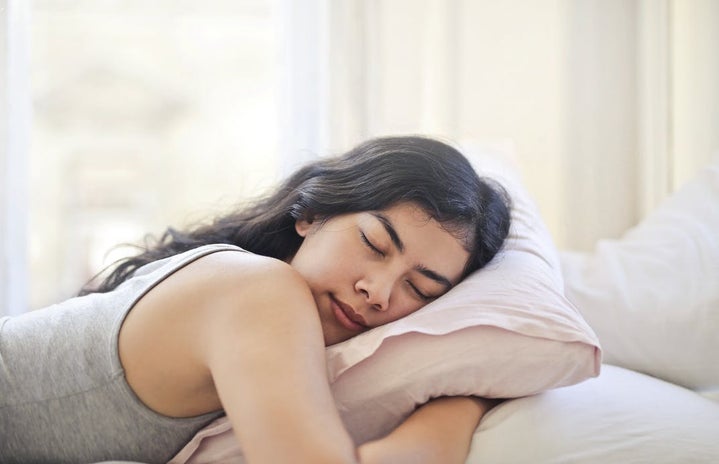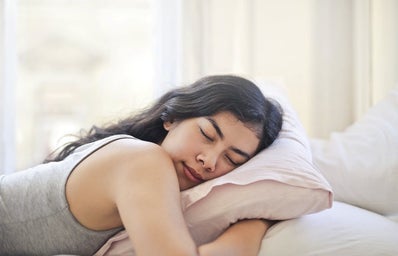If you haven’t yet heard about essential oils, it’s time to jump on the trend. These plant-based volatile compounds can replace the medicine in your medicine cabinet with all natural, healthy alternatives. One of the most common ways that people use essential oils is to help fall and stay asleep. They have an amazing ability to relax you before bed and help keep you asleep. To put them to the test, some Her Campus Western members tried them out for a week using multiple different methods, such as putting them in baths, in tea, and topically! We tried out lavender, doTERRA’s Clary Calm blend, and doTERRA’s Serenity blend.
Some of us, like third year Lauren Forster and fourth year Becca Serena, had tried essential oils in the past, with some using them frequently and others only on occasion. Serena explains how she used lavender essential oil as a kid to soothe her back to sleep when she’d get nightmares.
However, this was the first time some of us had ever tried essential oils. Chantal Hermetz, a second year student at Western, explains that she was very skeptical: “I always thought that essential oils worked more as a placebo effect.” Other people involved in this experiment were fourth year Alex Hawkins, fourth year Taylor Van Binsbergen, and second year Amy Scott.
**Disclaimer: not all essential oils brands are made equally! We used doTERRA since it is currently the safest and purest on the market. It is also the only brand you are able to ingest. Please do your research before using essential oils topically or internally!
1. Lavender
Lavender is known for its calming properties and is the most commonly used essential oil in the world.
Forster noted how strong the oil smelled: “I have used essential oils in the past, and I never had such a potent bottle. As such, I decided to use less than I usually would.” It is important to know the potency of your bottles and dilute in a carrier oil, like coconut oil, if they smell too strong for you.
Scott decided to try lavender oil in her tea before bed. “It did not make me feel sleepy or at peace. However, I tried it again a few days later and I felt like I had a more calming and relaxing sleep.”
While Scott did not get consistent results, Forster found it to be a bit more helpful and even came up with a delicious treat! She added a drop to her tea, along with some other goodies: “Besides the lavender oil, the Earl Grey had vanilla extract, almond milk, and honey, and it tasted as delicious as it sounds. The lavender was just barely there in both taste and smell (I was careful to not add too much) but I definitely felt a greater sense of relaxation after I was done my tea for the night.”
Another method we tried was a topical application. This is done by rubbing the oils onto your skin, with the most effective places being your pulse points, like your wrists, neck, or spine. These areas increase the essential oil absorption into your body as they are close to major bloodlines.
When Forster tried the topical application of lavender essential oil, she “could smell the lavender for hours afterward” and felt that it helped her remain calm while working.
Hermetz found similar success. She found that she was more relaxed just ten minutes after applying it. “I think it’s because I recognized the calming scent as a reminder to shut my brain off and go to sleep.”
2. doTERRA Clary Calm blend
The next oil we tried was the doTERRA Clary Calm blend. This blend was created as a women’s monthly blend to help alleviate uncomfortable menstrual symptoms, such as cramping and mood swings. However, we also found it works surprisingly well to help us fall asleep!
Van Binsbergen applied Clary Calm to her face before going to bed. “I fell asleep almost instantly (but I also used Lush Sleepy Lotion).” With the combination of Lush’s Sleepy Lotion and the essential oil, it is hard to say which one caused her to fall asleep easily. However, after a few days she did say that “Clary Calm has helped me sleep and feel a lot calmer.”
3. doTERRA’s Serenity blend
The last oil that we tried was doTERRA’s Serenity blend. This essential oil blend was created specifically to aid in falling and staying asleep.
We used this one topically as well. Scott found that Serenity made her feel “a sense of calmness” when she applied the oil to her wrists before bed.
I had similar success with Serenity. This oil never fails to help me unwind before bed, especially after a stressful day. My favourite ways to use it are topically on my temples or in the bath before bed.
Hawkins used the oil on her wrists and feet before bed. She said that the oil made her feel “more relaxed and like [she] was able to fall asleep sooner.”
Serena decided to use Serenity in her essential oil diffuser. “[I put] a couple drops in my petal diffuser throughout the entire day and before bed to relax me and aid with anxiety. It worked! My demeanor was already calmer and I was ready to sleep in no time.”
Overall, we all enjoyed our week with essential oils! While they may not have given 100% results every time we used them, we all agree that they do give some benefits and can aid in falling asleep. Forster’s “personal verdict would be that lavender essential oil does help with relaxation and minimizing anxiety and stress, but may not be super beneficial for other things.” Scott was “satisfied with the oils.” She says that “the scents can be overwhelming at times but I am happy with the outcomes!”
While I am a die-hard essential oil user, I love learning how the oils affect everyone differently. This experiment was a great learning experience for us all.
Want to get your own amazing night’s sleep? Contact Sarah Nagus on Facebook or at sarah.nagus@gmail.com to learn how you can get your hands on these amazing oils!
Related articles:
- 10 Body Positive AF Instagram Accounts To Start Your New Year Right
- How To Increase Your Libido—Naturally
- Get GLOWING: 5 Tips For Your Best Skin
Want more HCW? Check us out on social media!


